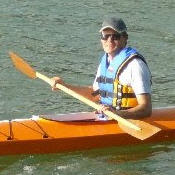We went to North Harbour Stadium in Albany where we met up with neighbours who had also 'borrowed' an extra child to watch the match. We went to see our local side, North Harbour, play Auckland in the Battle of the Bridge, the local derby in the NPC competition. Unfortunately North Harbour were beaten 22-29. On a positive side though, all the kids got an autograph and a chat from All Black Joe Rokocoko.

When we got back the weather had closed in and we spent the rest of the day indoors. Sunday was a different story though. Over night it had officially become spring with the introduction of daylight saving time, and outside it was bright and warm.
The first job I tacked was to glue on the inwales. I mixed some epoxy with plenty of micro fibres for extra strength and to fill any gaps. Once the hull was spread with a line of epoxy along the top edge, I screwed the inwales on using the holes I made when dry fitting, and added a few extra to pull everything in line where there were gaps.

With all the seams on the kayak taped up, I adjusted the corners on the bulkheads to account for the epoxy fillets under the tape and dry fitted all the athwartship pieces again. After a little fiddling I had all of them fitting quite snugly apart from the forward deck beam, which wasn't as wide as the boat any more. This I made right by pulling the boat together by a webbing strap attached to temporary screws in the top of the inwales.

Again, a micro fibre rich mix of epoxy was made up to glue the deck beams and bulkheads in place, making especially sure that there were no gaps left around the bulkheads. These will seal off an air-tight compartment at each end of the kayak, which provide flotation in the event of the boat getting swamped. Some of the pieces were wedged firm in the hull, others I added a couple of screws or tacks to keep firm while I added fillets of epoxy with low density micro balloons added before adding glass tape and neat epoxy to strengthen the joins.
Finally, I added pins to the centre of all the members, and to the point of the bow and the centre of the transom and ran a line to check everything was straight. There's a good line running right down the boat, with only the forward bulkhead out of line by maybe 3mm. Hopefully this will be reduced when the webbing strap comes off, and failing that, I should be able to pull it straight when fitting the deck.

















